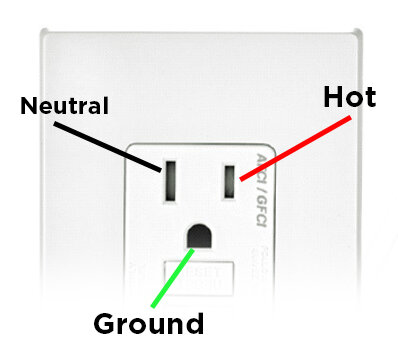120 Volts vs 12 Volts vs 24 Volts: What Gives?
Electrical energy traveling through power lines.
Updated 9/11/24 by Angela Rogers
This week we're gonna answer one of the most asked, yet elusive lighting questions in the industry: Why do certain lights operate on 120 Volts versus 12 or 24 Volts? And why does voltage even matter? It's all about wattage, right? Not exactly. Lights operate on different voltages for specialized purposes. Here in America 120, 12, and 24 Volt lighting systems are the most common. So what are the differences between them?
What is Voltage?
First, let's explain what exactly voltage is. Voltage is the measure of electrical potential, expressed in volts (V). In layman's terms, it's the "force" or amount of energy required to push the electrical current through a conductor from one point to another. Voltage is also often referred to as electrical pressure, electric tension, and (electrical) potential difference.
Are Electromotive Force and Voltage the Same?
One term that comes up when discussing voltage is electromotive force, or EMF. Many people assume that since both are measured in volts, they are the same thing. However, this is not the case. EMF is the electric potential products by an electrochemical cell or by changing the magnetic field. Examples include batteries, solar cells, and generators.
What is Standard Voltage?
In American homes, the standard voltage supply that travels from you local utility substation to your home is 120 Volts. It is commonly referred to as "line voltage" by electricians, the US National Electrical Code (NEC), and other industry experts. Nearly all indoor residential light fixtures and appliances in the U.S. run on line voltage. A 120-volt light bulb can typically be screwed into an indoor light fixture and operate correctly without further complication. Likewise, most household electrical equipment runs on 120V and can simply be plugged into an indoor outlet.
Lighting Fact: Other common names for standard voltage include "mains power", "utility power", and "grid power".
A Tale of Two Currents - Alternating Current vs Direct Current
As mentioned earlier, the voltage carries (or pushes) the electrical current with it as it travels between two points. That current can be one of type types: alternating (AC) or direct (DC). The difference between the two is how the energy flows.
Originally, the electrical system in the US used direct current. Invented by Thomas Edison, DC flows in only one direction. Though it is a more stable source of electricity, DC is difficult to transmit it over long distances and it cannot be transmitted at high voltage over power lines. Nicola Tesla came up with a better solution: alternating current. AC is able to alternate its flow periodically, making it far easier to transmit though the power grid at higher voltages. It is also more cost effective.
Today, all homes and businesses in the US use AC current. Large appliances, most lights, and other equipment use AC. Other countries use AC as well, though the voltages differ from place to place. DC is also still used. Devices that run off of batteries, uses an AC adapter, or uses a USB cable all run on DC.
Anatomy of A Standard Electrical Outlet
Most electrical outlets in US homes are polarized. These outlets accept 2 and 3-prong plugs, and are characterized by one of the vertical openings being larger than the other. You can learn more about polarized plugs in our blog post Polarized vs. Non-Polarized Plugs.
What is Low Voltage?
"Low voltage" refers to 12 Volts and 24 Volts, which is commonly used for outdoor lighting. A transformer (or LED driver for LEDs) is required to "step down" (reduce/convert) the standard 120V power supply provided to your home into a 12V or 24V supply for your lights. In most cases, whether you need a 12V or 24V light bulb simply depends on the needs of your light fixture.
Lighting Fact: NEC defines low voltage as voltages ranging from 0 to 40 Volts.
When it comes to LED rope light, or LED tape light for that matter, you may have the option to choose between a 12-volt or 24-volt light. The one you need depends on how long you need your rope or tape light to be. The longer your continuous strand of rope or tape light, the more voltage you will need to travel across its entire length without losing brightness. This loss of voltage is a phenomenon called voltage drop. We discuss 12V vs. 24V tape light further in our LED tape light guide.
Why is Low Voltage Used Outdoors?
You might be wondering why low voltage is used doors? The reason is because it's safer. If the wire for a 120V light source (which would run underground or on a building's exterior, if used outdoors) were to become exposed, it would be very dangerous for someone to come in contact with, possibly resulting in a dangerous electric shock or other electrical hazard.
For a low voltage light source, this risk is significantly reduced and would result in little to no harm in most scenarios. The rule of thumb: if your lights are being used somewhere where the wiring could become exposed, and therefore hazardous, it is always better to opt for low voltage lighting if given the choice.
These are just the three most common residential voltages in America. They are by no means the only voltages that can be used to operate lighting systems or appliances. Many US commercial buildings run on 277V, and in Europe the standard voltage supply is 220V—a major reason why American appliances won't work in overseas outlets. Some lighting systems require even higher voltages. When purchasing a new light source, first and foremost, you must always match your light bulb to the requirements of your fixture.
Have any questions about line or low voltage lighting? Our staff of US-based lighting experts can help! Call 1-800-624-4488 today!











